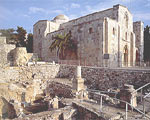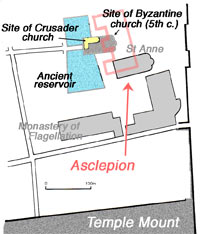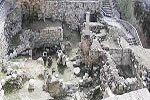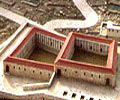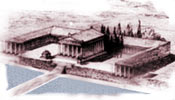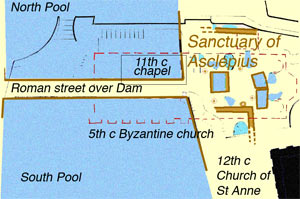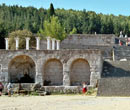
Jesus miracle site?
Jerusalem. The Church of St Anne and the excavated site of the "pools of Bethesda".
The Church of St. Anne is also known as the Church of the Paralytic in homage to the purported Jesus miracle.
But the miracle is bogus. The yarn was concocted to scupper the ancient cult of Asclepius, the Greek god of healing.
"Then Eliashib the high priest rose up with his brethren the priests, and they builded the sheep gate; they sanctified it, and set up the doors of it; even unto the tower of Meah they sanctified it, unto the tower of Hananeel."
– Nehemiah 3.1.
"In Hadrian's grid plan a street ran across the dyke dividing the ancient pools to terminate in front of the temple."
– O'Connor, The Holyland, p30.
Limited excavation around the Church of St Anne in 1957 and 1962 revealed the foundation walls of the sanctuary of Asclepius and numerous pools and basins, overlaid by later Byzantine and Crusader churches.
Stirring the water
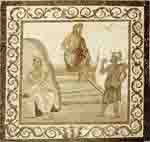
Asclepius rises from the healing pool. (Asclepieion mosaic, Kos, Greece)
So popular and widespread was the following of Asclepius that the cult not only had sanctuaries throughout the Greek world but even had a shrine within the shadow of the Jewish Temple.
The cult of Asclepius, combined veneration of the god with the healing arts.
The deep reservoirs of Bethesda were built, possibly as early as the 2nd century BC, to store winter rains for use in the Jewish temple.
Nearby shallow pools and basins offered healing and recuperative services.
"Five Porticoes"
Dreamland. Is that five or seven porticoes? Christian apologetics' bizarre and dangerous concept.
How the Asclepieion may have looked, with the sanitaria arranged to provide treatment in the small pools and baths.
|
Miracles - an Introduction
Jesus steals the magic of Asclepius!
During the second Jewish war of 132-135 the wrecked city of Jerusalem saw no major conflicts, although the rebel leader Simon ben Kosiba is said to have offered sacrifices at the site of the destroyed temple. Post-war a new Roman city was built on ruins which had stood abandoned for sixty years. This new colony – Aelia Capitolina – was named by Emperor Hadrian for the gods of Rome (Jupiter, Juno and Minerva) and himself (Pulbius Aelius Hadrianus). In the northeastern sector of the new city, just beyond the eastern forum, Hadrian's architects re-developed an ancient Asclepieion. It was sited close by the Sheep Gate (later Lions' or St Stephen's Gate), beyond which Jews had marshalled vast flocks of animals intended for ritual slaughter. The healing shrine probably dates to the earliest Greek presence in the city in the 4th century BC. The existence of a pagan shrine within the shadow of Temple Mount speaks volumes about Jewish fidelity to their tribal god Yahweh. At the pool of Bethesda, in a depression fed by natural springs, were reservoirs and pools servicing the needs of the healing sanctuary. Holistic treatment on offer at an asclepieion included massage, herbal infusions, dream interpretation and bathing. In the Hadrianic redevelopment the Asclepieion was given an enlarged precinct and a temple to the god. The 2nd century evangelists, hustling for position in a world full of gods and convinced that they alone possessed divine truth, set out to put the rival cult out of business. It was "useful", therefore, for gospeller John to have his divine hero perform superior magic at the very spot that the god Asclepius worked his wonders. With the triumph of Constantine this shrine to a pagan god – and the rudimentary hospital that it provided – were soon reduced to ruin.
Miracle, Magic or Myth?
In locating his miracle gospeller John uses the word "probatike" ("of sheep") which since the time of the Church Fathers has been equated with "sheep pool" and this in turn has been equated with the pool of Bethesda. But the identification is wrong. Washing thousands of sheep in a reservoir of such depth would have been ludicrous – and would have made the whole reservoir useless for any other purpose. What the misidentification illustrates is that only a century after the purported "miracle" the theorists of the Church were hard-pressed to fit the fable into a valid landscape. The "sheep pool" was more probably the Pool of Israel, closer to the Sheep Gate and closer to Temple Mount (it is now covered by a car park) – and was thus identified during the Crusader period. But if the Jesus miracle is moved further west to this pool the rest of the story doesn't fit at all! Why would the sick gather around a sheep dip? Notice that the paralytic in John's yarn does NOT "believe" in Jesus (a shortcoming which in Nazareth prevented JC from doing "mighty work"). He does not even know who Jesus is (John 5.13) but evidently the invalid does believe in the healing powers of the pool when "stirred up" (that is to say, by the rival god). Amusingly, the "stirred waters" bit troubled some early Christians (a natural manifestation of the water flow but seemingly the action of non-Christian spirits). So some copies of John's gospel added in an acceptable explanation: the water was stirred by an angel of the Lord! Healing was the prize of a cruel race:
The second, more ominous, part of the Christian "Bethesda" message occurs a few verses later when JC again encounters the healed man. NO cheery words of encouragement from Mr Loving Kindness, NO stress upon "faith', but a threat to the poor man should he sin again.
The priestly purpose of the "healing miracle" of Bethesda was to have Jesus neutralise the ancient magic of Asclepius.
Those "five porches" Archaeology does not support the claim made by Christian apologists (following the lead of 3rd century Origen) that "porticos" surrounded the two reservoirs. By supposing that another ran across the central "dam", they derive the "five porches" referred to by John. And yet the sick and lame would never enter 13 metre deep reservoirs (and nor would sheep be washed in them!). It was the numerous small, medicinal baths within the Asclepieion which were used for healing. If the "five porches" referred to anything, it is rather more likely that the Asclepieion here, as elsewhere, had an E-shape facing the pools and thus might be said to have "five porches".
Dumbing-down In the empire of Christ created by the Christian emperors, Asclepia were quite unnecessary. Prayer and the touch of a saint's bones were the only medicine a Christian required. God himself would decide who lived or died. To interfere with that divine judgement was sacrilege and the Devil's work. To totally eradicate their ancient rival, and armed with the "gospel truth" as their guide, the Byzantines built a church directly above the sanctuary of the old god. On its debris arose first a church to Jesus' mother. As the legend grew, the original church of Mary was replaced by a church honouring Jesus' purported grandmother Anne, a character without any gospel pedigree. In the dreamscape of Christian fantasy, not a healing shrine of Asclepius but the house of Mary's childhood underlay the basilica! Does that make Mary a water nymph?
Sources:
'Save' a friend e-mail this page
Copyright © 2007
by Kenneth Humphreys.
|
|||||||||||||||||||||||||||||||||||||||||||||||||
